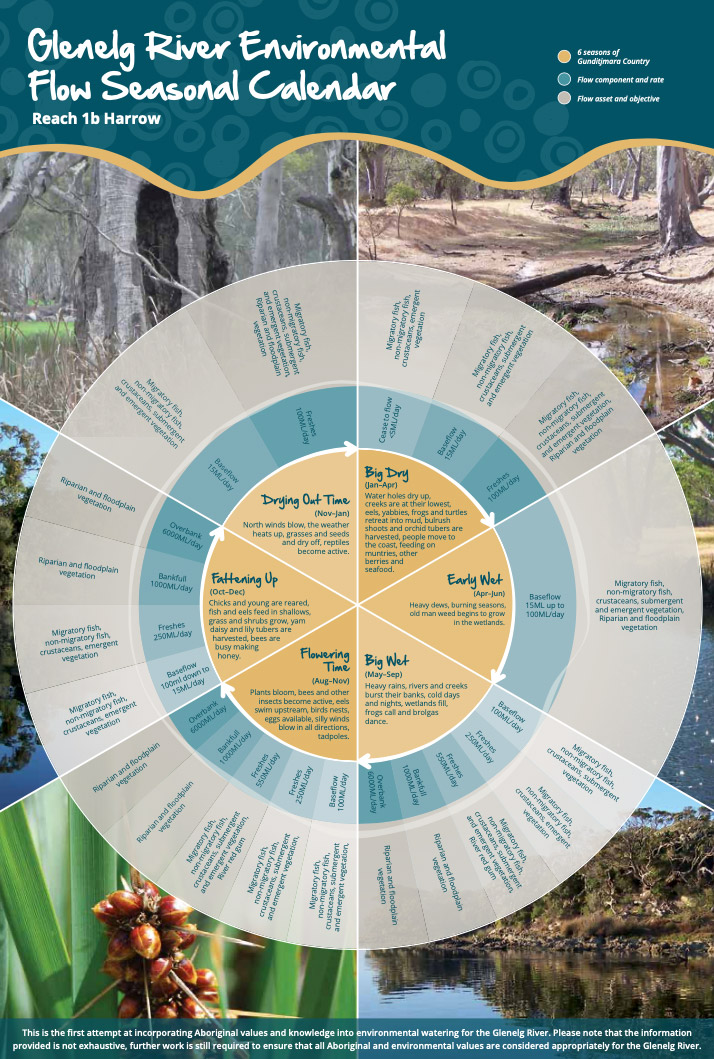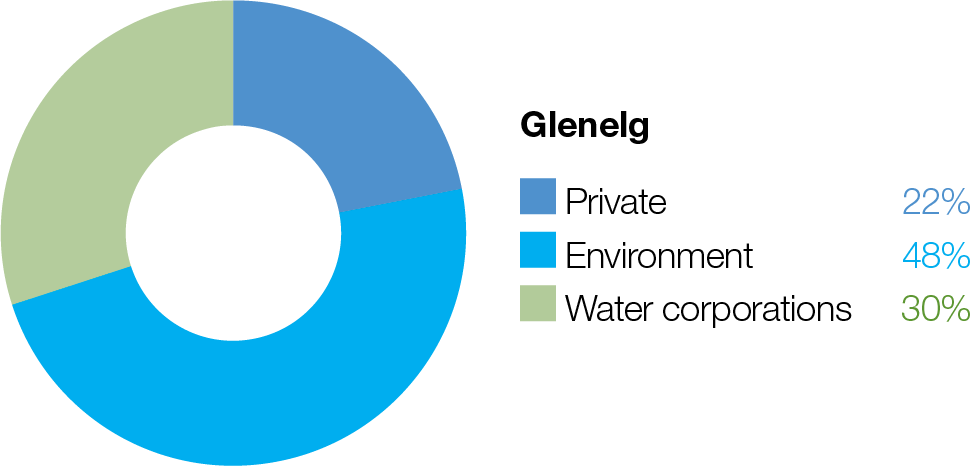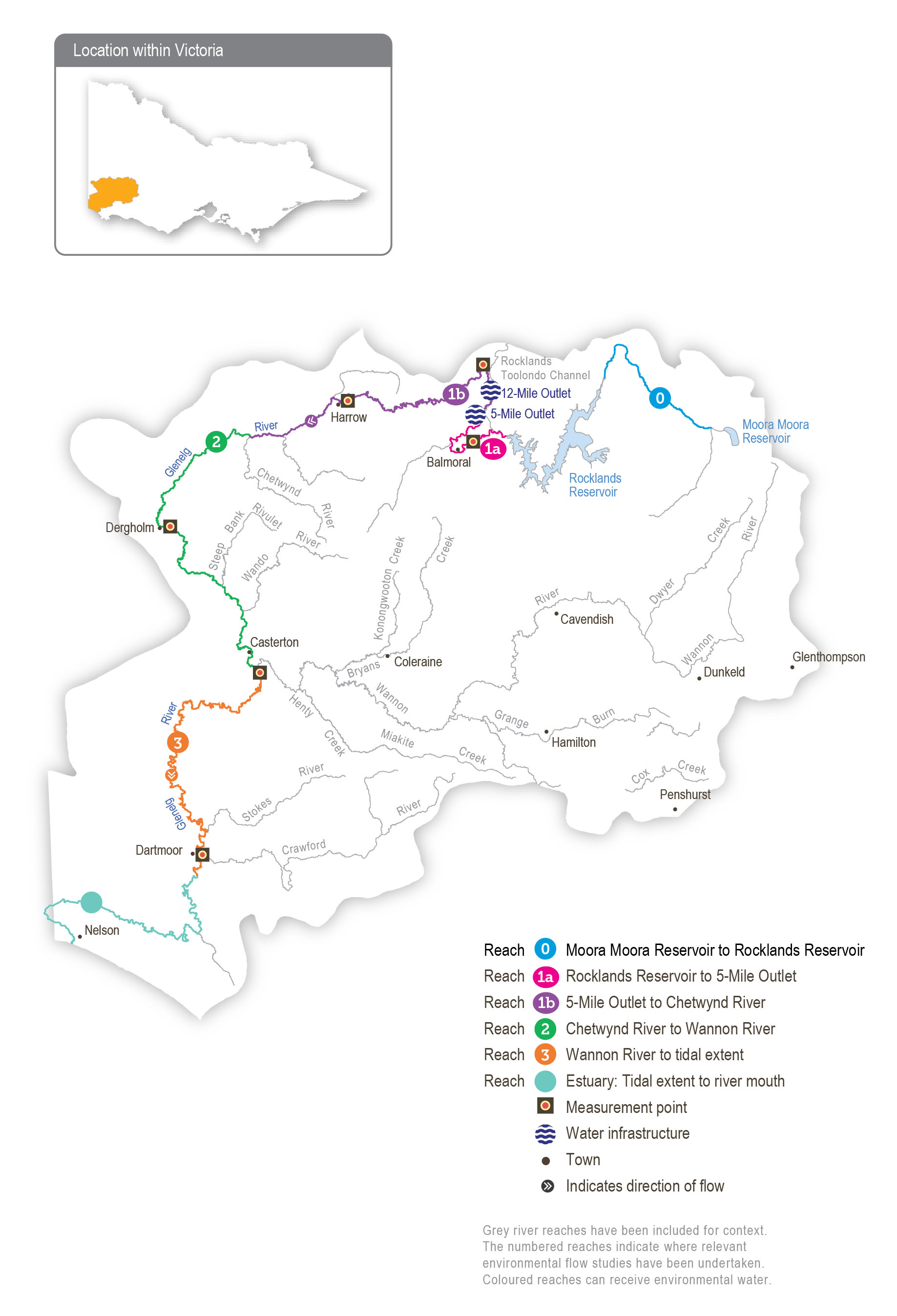The Glenelg River, known as Bochara in Dhauwurd Wurrung, Pawur in Bunganditj, and Bogara in Wergaia-Jadawadjali languages, is a significant feature in the cultural landscape of south-western Victoria. The river features in the region's creation stories. Bochara-Bogara-Pawur (Glenelg River) continues to be an important place for Traditional Owners, who have inhabited the area for thousands of years, using the rich resources available along the river and the associated habitats.
In planning for environmental flows in the Glenelg River, several on-Country meetings have been held to increase Traditional Owner involvement in environmental watering. There has also been an increase in communicating operational changes to water deliveries. When planning for the Glenelg River seasonal watering proposal, the Gunditj Mirring Traditional Owners Aboriginal Corporation, Barengi Gadjin Land Council, Burrandies Aboriginal Corporation, and Glenelg Hopkins CMA have considered:
- supporting the health of cultural heritage sites (such as scar trees, ring trees, stone structures, middens, and rock paintings) and native plants, which are sources of traditional foods and medicines
- that improving the health and abundance of totem species and their habitat by delivering water for the environment also benefits Traditional Owners' spiritual well-being
- supporting contemporary cultural events such as the Johnny Mullagh cricket match in March each year. A summer fresh is delivered to support environmental outcomes, but it also supports this event on the river.
Aboriginal Peoples across the Glenelg catchment have retained a strong identity and connection to the traditional lands for which they have custodial rights and responsibilities. Cultural values in the Bochara-Bogara-Pawur (Glenelg River) system align strongly with environmental values. Cultural values are holistic and interrelated: they are bound up with the health of the river system overall and the Country of which the river is part. Traditional Owners' well-being is connected to the health of the river and of Country.
Gunditjmara Traditional Owners have identified that it is a priority to spend time on the river and increase cultural practices and connection to Country. They have highlighted the importance of increasing ceremonial and on-Country gatherings along the river, including at Casterton and the Glenelg Estuary.
The Glenelg River Yarns website was launched in late 2021 as part of the Glenelg River Cultural Flows project. The website shares cultural values and stories on a virtual tour and welcomes all visitors to Country.
Figure 4.2.2 Glenelg River Environmental Flow Seasonal Calendar

Figure 4.2.2 was produced by the Gunditj Mirring Traditional Owners Aboriginal Corporation and describes the six seasons of Gunditjmara Country. The northern part of the river upstream of the Harrow area is in Jadawadjali Country, and the southwestern part of the system is in Boandik Country. The calendar describes the six seasons alongside flow components for reach 1b of the Glenelg River – from 5-Mile Outlet to Chetwynd River – and aligns them with corresponding watering effects and objectives. The calendar reflects the seasonal flow conditions that all Traditional Owner groups recognise.
The value of the calendar is in its clear visual depiction of Traditional Owners' knowledge, developed over many generations, of how varying flows correspond to seasonal conditions and broader environmental patterns. The six seasons will eventually be embedded in environmental flow recommendations and scenario planning in future years.
Increasing the involvement of Traditional Owners in the planning and managing environmental flows and ultimately providing opportunities to progress towards self-determination within the environmental watering program is a core commitment of the VEWH and the Glenelg Hopkins CMA. This is reinforced by a range of legislative and policy commitments, including the Water Act 1989, the Victorian Aboriginal Affairs Framework, the 2016 Water for Victoria, and in some cases, agreements under the Traditional Owner Settlement Act 2010.
Where Traditional Owners are more deeply involved in the planning and/or delivery of environmental flows for a particular site, their contribution is acknowledged in Table 4.2.1 with an icon. The use of this icon is not intended to indicate that these activities are meeting all the needs of Traditional Owners, but is incorporated in the spirit of valuing their contribution and indicating progress towards deeper involvement.
 | Watering planned and/or delivered in partnership with Traditional Owners to support Aboriginal cultural values and uses |
The timing of the summer/autumn fresh is planned to support the annual Johnny Mullagh Cup cricket match between Gunditj Mirring and Barengi Gadjin Traditional Owners.





